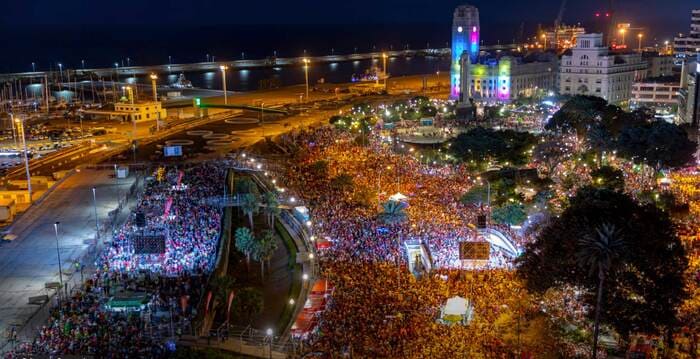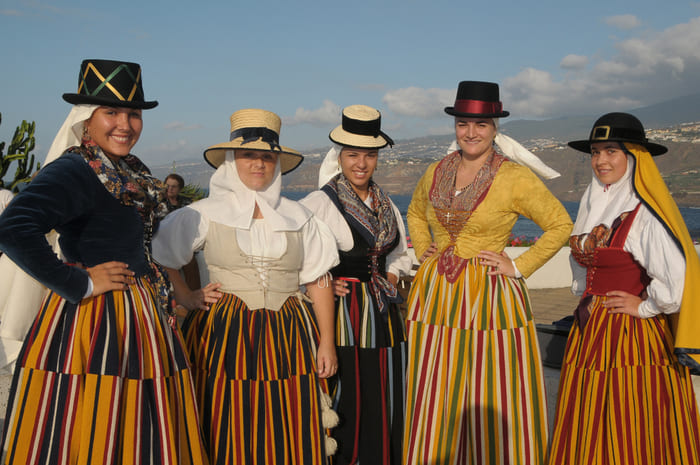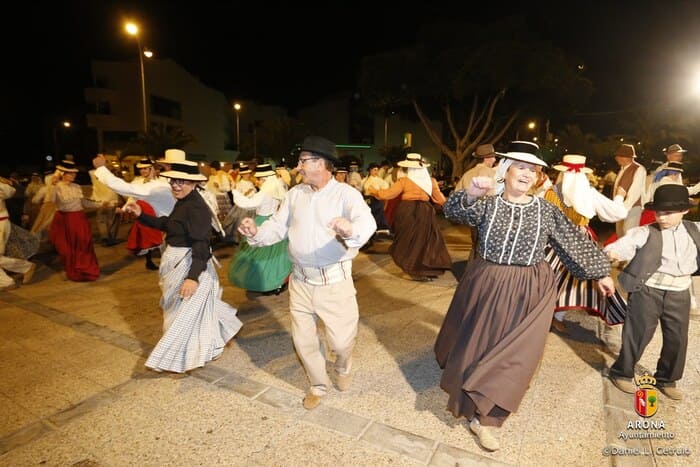Traditional festivals
View Contents
ToggleTenerife is a melting pot of festivities that not only entertain but also enrich the cultural fabric of the island. From the world-famous carnivals to the traditional romerías and baile de magos, each event reflects the history and traditions of this vibrant island community.
Carnavales
The Carnivals of Tenerife are world-renowned events that transform the streets of Santa Cruz into a spectacular open-air theater, filled with music, dance, and extravagance. Celebrated every February, this festival is considered one of the best carnivals in the world, second only to Rio de Janeiro in terms of size and splendor.
Origin and Significance
The Carnival of Tenerife has its roots in the medieval European celebrations before Lent, where the period was observed with feasts and dances, symbolizing a last indulgence before the austerity of Lent. Over the centuries, these traditions blended with the cultural influences of the indigenous Canarians and African rhythms, creating a unique event.
Key Components of the Carnival
- Desfile: The parades are the heart of the carnival, especially the «Cosmo» or Grand Carnival Parade, which sees thousands of costumed participants marching through the streets. Elaborate floats and groups of murga (bands of comic and satirical music) and comparsas (dance and percussion groups) add to the festive atmosphere.
- Gala de Elección de la Reina: One of the most anticipated events is the election of the Carnival Queen, featuring spectacular costumes that are true works of art. These costumes, often adorned with feathers, sequins, and lights, can weigh up to several hundred kilos and require months of meticulous work and dedication to create.
- Murgas and Comparsas: Murgas are groups that perform humorous songs commenting on politics and social events, while comparsas provide the vibrant rhythm of the carnival with their samba-style dances. Both are traditional competitions within the carnival that attract large audiences.
- Entierro de la Sardina: This quirky event marks the official closure of the carnival. Symbolizing the burial of the past and purification before Lent, a giant papier-mâché sardine is paraded through the city before being burned in a theatrical and humorous ceremony, accompanied by «widows» who dramatically cry and lament the end of the festivities.
- Street Carnival: Street carnival is the real jewel of the carnivals. Unlike other world famous carnivals, in Santa Cruz de Tenerife, everyone dresses up in costumes, there is no social class distinction, there is a spirit of fun that is not comparable to any other carnival in the world.

Romerías
Romerías in Tenerife are one of the most authentic expressions of Canarian culture and traditions. These deeply rooted festivities combine religious processions and festivals where participants, dressed in traditional costumes, honor their patron saints. Romerías are events of great importance in every town and city on the island, celebrated with fervor and enthusiasm that highlight Tenerife’s rich cultural heritage.
Origin of Romerías
The origin of romerías dates back to medieval European religious festivities, adapted in the Canary Islands to include elements of the native Guanche culture and the influences of Spanish settlers. These celebrations have been maintained over the centuries as a vital part of community life, serving as an opportunity to strengthen social bonds and pass down traditions from generation to generation.
Key Elements of a Romería
- Procession: The essence of a romería is the procession. Participants, called «romeros,» dress in traditional Canarian attire and parade behind the image of the town’s patron saint, carried on a decorated cart. This cart is pulled by oxen and followed by other carts carrying groups playing folk music, dancing, and offering local products to the spectators.
- Traditional Costumes: Men typically wear trousers, vests, and decorated hats, while women wear long skirts, embroidered blouses, and hats adorned with flowers. These costumes are not only festive elements but also a way to honor and preserve Canarian history and identity.
- Offerings and Gastronomy: During the romería, it is common for offerings of food and local products to be made to the saint as a sign of gratitude and blessing for the crops and the community. Additionally, free servings of wrinkled potatoes, gofio, cheeses, local wines, and other typical products are distributed to attendees, turning the romería into a gastronomic celebration as well.
Notable Romerías in Tenerife
- Romería of San Benito Abad in La Laguna: The largest in Tenerife and one of the most attended, drawing thousands of people every July. It is known for its long procession of carts and the festive atmosphere that fills the streets of La Laguna.
- Romería of San Isidro in La Orotava: Celebrated in honor of San Isidro Labrador, the patron saint of farmers, this romería is famous for its colorful parade of carts and its deep respect for the agricultural traditions of the valley.
- Romería of San Marcos in Tegueste: The romería de Tegueste is the first of the year and is possibly the most popular of all those held in Tenerife. It brings together people of all ages who want to have a good time in the smallest municipality on the island.

Bailes de magos
The Baile de Magos is one of the most picturesque and emblematic festivities in Tenerife, where locals celebrate their culture and traditions with an enthusiasm that captivates everyone present. This event offers a unique opportunity to delve into traditional Canarian culture through music, dance, food, and typical attire.
Origin and Meaning of Baile de Magos
The term «mago» in the Canary Islands traditionally refers to the peasants or rural inhabitants of the islands. Thus, the Baile de Magos is a celebration that honors the agricultural roots of the region and the simple life of its ancestors. It is a community event that strengthens social bonds and conveys pride in customs passed down from generation to generation.
Key Elements of Baile de Magos
- Traditional Costumes: One of the most distinctive features of the Baile de Magos is the wearing of traditional costumes. Men wear striped pants, white shirts, vests, sashes, and hats known as «mago hats,» while women wear long dresses, embroidered aprons, and decorated hats. These costumes are not only a visual feast but also an expression of respect and celebration of Canarian identity.
- Music and Dance: The music accompanying the Baile de Magos typically includes traditional instruments such as the timple, guitar, and castanets. Canarian folk melodies encourage participants to dance traditional styles such as isa, folías, malagueñas, and tajarastes. These dances are not only fun but also a way to preserve and teach the musical and dance arts of the region.
- Traditional Food: The event is also a celebration of Canarian gastronomy. Attendees enjoy typical dishes such as «papas arrugadas» with mojo picón, «queso asado», «carne fiesta», and other local delicacies that are offered at stalls and tables throughout the event venue.
Notable Bailes de Magos in Tenerife
- Los Realejos: The night begins with a dinner for those who have previously reserved a table and are dressed in the traditional attire of the Canary Islands, with the latter being a fundamental requirement to consolidate the festive atmosphere characteristic of Tenerife’s romerías and Baile de Magos.
- Santa Cruz de Tenerife: The Baile de Magos in Santa Cruz is one of the most traditional events of the May Festivities in the capital of Tenerife, which has come to host more than 10,000 magos and magas, dressed in the traditional attire of the Canary Islands.
- La Orotava: During the Patron Saint Festivities of La Orotava, the highlights include the Corpus Christi events, the famous Alfombras de La Orotava, the Baile de Magos, and the Romería of San Isidro Labrador and Santa María de la Cabeza, which are generally celebrated in June.

